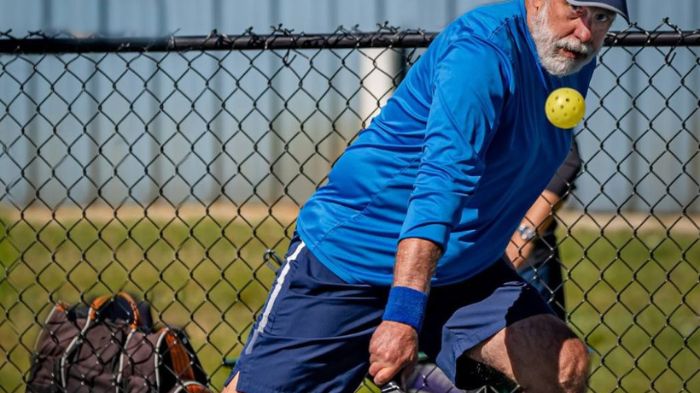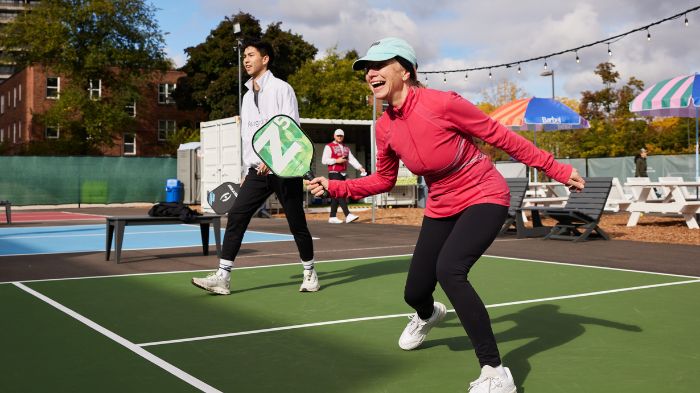If you’re an avid pickleball player who has recently experienced a torn meniscus, you may be wondering if it’s possible to continue enjoying the sport you love. A torn meniscus can be a painful and limiting injury, affecting your knee’s stability and mobility.
However, the good news is that with the right precautions and guidance, it may still be possible to play pickleball with a torn meniscus.
In this blog, we will delve into the topic and discuss the implications of a torn meniscus on playing pickleball, the potential risks involved, and the precautions you should take to protect your knee and promote healing.

Whether you’re eager to get back on the court or seeking advice for a friend or loved one, read on to learn more about playing pickleball on clay courts with a torn meniscus and how to make informed decisions about your recovery and sport participation.
What Is a Torn Meniscus?
A torn meniscus is a common knee injury that can occur during physical activities such as sports or even as a result of everyday movements. The meniscus is a C-shaped piece of cartilage that acts as a cushion and shock absorber between the thigh bone (femur) and the shinbone (tibia). Each knee has two menisci, one on the inner side (medial meniscus) and one on the outer side (lateral meniscus).
A torn meniscus happens when this cartilage is damaged or torn, often due to a twisting motion or direct force on the knee joint. Athletes involved in sports that require sudden changes in direction, pivoting, or squatting, like pickleball, are particularly prone to this type of injury.
Symptoms of a torn meniscus may include pain, swelling, stiffness, a catching or locking sensation in the knee, difficulty straightening the leg, and decreased range of motion.
It is essential to understand the nature of the injury, seek proper medical evaluation and advice, and follow appropriate treatment to promote healing and minimize the risk of further complications.
Can I Play Pickleball With A Torn Meniscus?
Playing pickleball with a torn meniscus is a decision that should be carefully considered and discussed with a healthcare professional. While it is possible to continue playing pickleball with a torn meniscus, it is important to understand the potential risks, take necessary precautions, and listen to your body throughout the recovery process.
Here are some key points to consider when determining whether you can play pickleball with a torn meniscus
- Consultation with a Healthcare Professional: The first step is to consult with a healthcare professional, such as an orthopedic specialist or sports medicine physician. They will assess the severity of your meniscus tear, consider any other existing knee conditions, and provide personalized advice based on your specific situation.
- Understanding the Nature of the Injury: A torn meniscus can vary in severity, and the recommended course of action may differ depending on the extent of the tear. In some cases, conservative treatment methods such as rest, physical therapy, and rehabilitation exercises may be sufficient to heal the injury. In more severe cases, surgical intervention may be necessary.
- Precautions and Modifications: If you decide to continue playing pickleball with a torn meniscus, it is crucial to take precautions to protect your knee and prevent further damage. This may include modifying your gameplay, avoiding sudden pivoting or twisting motions, and wearing a supportive knee brace. It is important to listen to your body and avoid any activities that cause pain or discomfort.
- Rehabilitation and Strengthening Exercises: Engaging in a structured rehabilitation program under the guidance of a physical therapist can be beneficial for healing the torn meniscus and restoring knee strength and stability. Strengthening exercises focusing on the muscles surrounding the knee can help provide support and reduce the strain on the injured meniscus.
- Monitoring and Adjusting Activity Level: It is essential to closely monitor your symptoms and adjust your activity level accordingly. If you experience increased pain, swelling, or instability during or after playing pickleball, it may be a sign that you need to modify your activities or take a break to allow for further healing.
- Individual Variations and Limitations: Each person’s experience with a torn meniscus can be unique. Factors such as age, overall knee health, and the specific characteristics of the tear can influence the decision to play pickleball. It is important to have an open and ongoing dialogue with your healthcare provider to assess your progress and determine the most appropriate level of activity.
How Can Play Pickleball Lead To a Torn Meniscus?

Playing pickleball involves quick movements, lateral shifts, and sudden changes in direction, which can increase the risk of sustaining a torn meniscus. Here are some ways in which playing pickleball can potentially lead to a torn meniscus:
- Twisting and Pivoting: Pickleball requires players to make quick twists and pivots while running on the court. These rapid movements can put significant stress on the knee joint, especially when combined with the weight-bearing load during gameplay. If the knee rotates forcefully while the foot is planted, it can cause the meniscus to tear.
- Sudden Stops and Starts: During pickleball, players often need to abruptly stop and change direction to reach the ball. These sudden stops and starts can put excessive pressure on the meniscus, particularly if the movements are not executed with proper technique or if the player lacks proper conditioning and muscle strength to support the knee.
- Overuse and Repetitive Movements: Regularly playing pickleball without adequate rest and recovery periods can lead to overuse injuries, including meniscal tears. The repetitive nature of the sport, with frequent running, lunging, and lateral movements, can place repetitive strain on the meniscus, increasing the likelihood of developing tears over time.
- Falling or Collisions: While pickleball is generally a non-contact sport, accidental falls or collisions with other players can occur. These incidents can cause direct trauma to the knee, resulting in meniscal tears. It is important to be cautious and aware of your surroundings to minimize the risk of such accidents.
- Pre-existing Knee Conditions: Individuals with pre-existing knee conditions, such as degenerative joint disease or previous knee injuries, may be more susceptible to meniscal tears while playing pickleball. These conditions can weaken the meniscus or make it more prone to injury, even with relatively low-impact movements.
How to Reduce Your Risk of a Torn Meniscus?
educing the risk of a torn meniscus involves taking preventive measures and adopting healthy habits to protect your knee joint. While injuries can happen, here are some tips to help minimize the risk of a torn meniscus.
- Warm-up and Stretching: Warm up those muscles and get the blood flowing before you hit the court. Take a few minutes for a light jog or some brisk walking to increase circulation and loosen up your tissues. Don’t forget to target those lower body muscles with specific stretches for your quadriceps, hamstrings, and calf muscles. You’ll enhance flexibility and reduce strain on your knee joints.
- Strengthen the Surrounding Muscles: It’s time to power up! Focus on exercises that strengthen the muscles supporting your knee joint. Amp up those quadriceps, hamstrings, hip abductors, and gluteal muscles. By building strength in these areas, you’ll improve knee alignment, absorb shock better, and give your meniscus the protection it needs during gameplay.
- Practice Proper Technique: Ace your technique on the pickleball court. Master the art of footwork, avoid sudden and excessive twisting or pivoting motions, and maintain solid body mechanics. Getting your fundamentals right and using proper form will distribute forces evenly across your knee joint, reducing the risk of injury.

- Use Protective Gear: Get your knees some love and support! Consider wearing a knee brace or using supportive athletic tape to provide stability to your knee joint. This extra layer of protection will keep your meniscus shielded from excessive movements and impacts during your intense pickleball sessions.
- Avoid Overuse and Fatigue: Give your body sufficient rest and recovery time between pickleball sessions. Overuse and fatigue can increase the risk of injuries, including meniscal tears. Listen to your body’s signals, and if you experience pain or discomfort, take a break and allow your knee to recover.
- Cross-Train and Maintain Overall Fitness: Incorporate cross-training and overall fitness activities into your routine to improve your overall strength and cardiovascular fitness. Engaging in a variety of exercises and activities, such as swimming, cycling, or strength training, can help prevent muscular imbalances, enhance joint stability, and reduce the risk of knee injuries.
- Maintain a Healthy Weight: Excess body weight can put additional stress on the knee joint and increase the risk of meniscal tears. Maintain a healthy weight through regular exercise and a balanced diet to reduce the load on your knees and minimize the risk of injury.
Also Read: pickleball college sport and paddle vs pickleball
FAQs
Playing pickleball with a torn meniscus is not recommended. It is important to allow your knee to heal properly before returning to any physical activities, including sports. Continuing to play with a torn meniscus can worsen the injury and potentially lead to further complications.
If you experience symptoms such as knee pain, swelling, stiffness, locking or catching sensations in the knee, or difficulty fully bending or straightening the knee, it is important to consult with a healthcare professional. They can perform a physical examination and may order additional tests, such as an MRI, to diagnose a torn meniscus.
Treatment for a torn meniscus depends on the severity and location of the tear. In some cases, conservative measures like rest, ice, compression, and physical therapy may be sufficient. However, more significant tears may require surgical intervention, such as arthroscopic surgery, to repair or remove the damaged portion of the meniscus.
The recovery time for a torn meniscus varies depending on the severity of the tear and the chosen treatment approach. In general, conservative treatment may take several weeks to months, while recovery from surgery can range from a few weeks to a few months. Your healthcare provider will provide specific guidance based on your individual circumstances.
Final Thoughts
In conclusion, playing pickleball with a torn meniscus is not advisable. It is crucial to prioritize your health and allow your knee to heal properly before returning to any physical activities, including sports. A torn meniscus can cause pain, and instability, and potentially worsen the injury if not given the necessary time to recover.
Seeking proper medical diagnosis and treatment, whether conservative or surgical, is essential for optimal healing. Remember, your long-term well-being is more important than short-term satisfaction on the pickleball court. Focus on your recovery, follow the guidance of healthcare professionals, and gradually ease back into physical activities under their supervision.
Prioritizing your knee’s health will not only lead to a smoother recovery but also help you enjoy pickleball and other activities in the future with a reduced risk of further complications.



